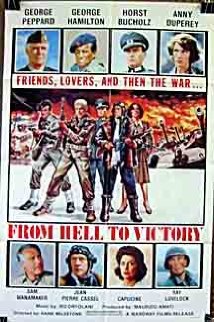Although “From Hell to Victory” is definitely the stronger of Lenzi’s two back-to-back epics, the storyline is completely convoluted and a complete rip-off of the previous film. In August, 1939, six friends meet in Paris and vow to reunite every year at a café no matter what the circumstances. Needless to say, WWII changes that plan. Brett (George Peppard) returns to the United States and becomes an OSS officer; Maurice (George Hamilton) finds himself on the beach at Dunkirk; Jurgen (Horst Buchholz) joins the German army and becomes disillusioned by Nazism; Fabienne (Anne Duperey) joins the French resistance. Rick (Jean-Pierre Cassel) joins the RAF, and Ray (Sam Wanamaker) becomes a war correspondent. Their paths will cross throughout the film, concluding with a bittersweet reunion in France during the summer of 1944.
Okay, that said, let’s analyze this “story” a little bit. Lenzi presents us with thumbnail sketches of his characters, and then jumps right into the action. Throughout, there is little to no character development; we simply follow several people through the war. This mess should not be as entertaining as it is. And, at first glance this looks like a very original piece of work, but fans of the director will realize that it’s just a complete hack job: for one thing, Lenzi’s characters are straight out of “The Greatest Battle”: Peppard mirrors Henry Fonda, in fact, even Ray Lovelock shows up here to play his pretty-boy son who turns into a hero (again); Hamilton is a takeoff of Giuliano Gemma, and even accompanies Lovelock on a mission to France (as Gemma did to North Africa in the previous film). Buchholz and Duperey fall in love, despite the fact that they are on opposite sides, a la Stacy Keach and Samantha Eggar… the list simply goes on. A series of climaxes are taken straight out of “The Greatest Battle” as well: main characters kill one another from a distance without realizing they’re killed a friend; the attack on a German bunker looks awfully familiar – this is the third time Lenzi has shot the same type of shoot-’em-up sequence! Secondly, Lenzi also stages much of the action around stock footage from other, better films. A good deal of the expensive-looking tank battles is lifted from the 1967 epic “The Dirty Heroes”, and almost all of the aerial battle photography is taken right out Enzo Castellari’s “Eagles over London”. The Dunkirk evacuation, in particular, is a total sham. What’s amazing is how well this stock footage is edited with the original sequences – I first saw “From Hell to Victory” a few years before “The Dirty Heroes” and “Eagles over London” and was awed by the scope; it wasn’t until I saw these films that I realized how much of Lenzi’s “work” was just cut from other movies. The only strong action sequence that stands out is a shootout atop the Eiffel Tower, which has got to be one of the most suspenseful, best-edited scenes ever shot. It compares to the most memorable moments in “The Last Hunter” and “The Dirty Dozen” – it’s just that good.
For all of the lack of originality, this piece still manages to be fairly entertaining. The cast are all confident and able; it’s finally nice to see Peppard in a role where he doesn’t have to constantly chew the scenery (he’s only a decent actor, not a dramatic genius); he simply is laid back and completely at ease with his surroundings. The ensemble cast does a pretty fair job as well: Ray Lovelock seems a lot more serious about his role than he did in “The Greatest Battle” and George Hamilton seems to be having plenty of fun as a French commando. Buchholz’s performance is a little hard to swallow at times, and his character transition from pacifist to die-hard Nazi is not very rational because it is barely developed. Even so, he tries hard and makes his material fairly believable, even if he is still just delivering dialogue rather than really acting.
Despite its many flaws, “From Hell to Victory” has become a widely circulated World War II film through the blessings of rental stores, flea markets and eBay. There’s nothing to indicate to American audiences that it is a spaghetti war flick: the principles are familiar American and European actors, and the film plays a lot like a Hollywood drama. Lenzi’s direction is somewhat restrained in comparison to his earlier efforts, almost as if he is trying to disguise his work. The credits list the crew and director under pseudonyms, rounding out its “Americanism”. It’s not a great film in any way, but it’s packed with action and engaging situations. Don’t go digging for this one, but if you see a dusty video copy, it’s worth checking out.

